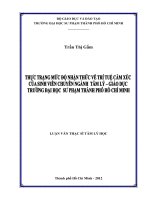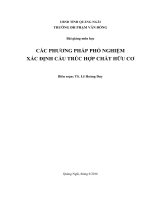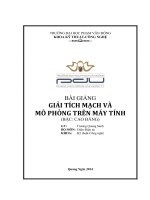SVT, NHỊP NHANH TRÊN THÁT, Đ H Y DƯỢC TP HCM
Bạn đang xem bản rút gọn của tài liệu. Xem và tải ngay bản đầy đủ của tài liệu tại đây (836.43 KB, 17 trang )
Supraventricular Tachycardia
(SVT)
❂
1 /250-1000 children
• More common in males younger than 4 months of
age
• Predisposing factors: fever, infection, drug exposures
❂
Etiologies
• 50% idiopathic
• 23% associated with congenital heart disease (CHD)
– VSD, Ebstein’s anomaly, L-TGA, cardiomyopathy
– Postoperative: TGA, ASD, AVSD, Fontan
• 22% Wolfe-Parkinson-White Syndrome (WPW)
SVT
❂
EKG
•
•
•
•
•
❂
Narrow complex
Similar morphology to QRS in sinus rhythm
Wide complex (SVT with aberrancy)
P wave obscured or buried in T wave
Short PR interval with delta wave suggests WPW
Younger children <4 mos
• Rate 230-320 beats per minutes (BPM)
• Can present with congestive heart failure (CHF)
❂
Older child
• Rate 150-250 BPM
• More likely to be WPW, concealed pathway, CHD
SVT Mechanisms
❂
❂
Age dependent
Reentry tachycardia
• Accessory pathway 90%
– WPW with preexcitation with ante grade conduction
• Concealed pathway (unidirectional) with only
retrograde VA conduction
❂
Atrial ectopic tachycardia
• Atrial flutter/fibrillation
❂
AV node re-entry tachycardia (AVNRT)
• More common in older children
❂
Junctional ectopic tachycardia
• Commonly seen in the postoperative periods
SVT
90% Narrow QRS tachycardia
P waves not visible, abnormal axis
SVT Mechanisms
Reentry Tachycardia
ORT, ART, AVNRT, PJRT
Accessory Pathway
WPW, URAP, Dual AVN
Orthodromic Reciprocating
Tachycardia
AP with rapid conduction, longer ERP
AV node with slow conduction, shorter ERP
Rate related BBB
Retrograde P may not be visible
Variable rates occurs with dual AVN
Wolff-Parkinson-White
Syndrome
Atrial Flutter
Rate 280-450 BPM (Infants may have more than 500 BPM)
Typical saw-tooth F waves
Atrial Flutter/Fibrillation
Mechanism
Reentry SVT
❂
Paroxysmal (sudden onset/termination)
❂
Two pathways: AVN and accessory pathway
❂
Accessory pathway: functional/anatomic
❂
Associated cardiac defects: Ebstein’s anomaly, L-TGA (congenitally
corrected TGA), single ventricle, WPW syndrome, hypertrophic
cardiomyopathy
Clinical
❂
Young infant
• Irritability, lethargy, dyspnea, vomiting,
mottling, cyanosis, CHF, hepatomegaly
❂
Older child
• Palpitation, dizziness, exercise
intolerance
• Throbbing neck pain from distended
neck vein
• Abdominal pain, nausea, vomiting
• Syncope from hypotension
Prognosis
❂
Present as infants
• Recurrence 20-30%
❂
Present >5 yrs of age
• Recurrence 78%
❂
WPW
• 1/3 lose accessory pathway
Acute Treatment-Stable
Patients
❂
❂
Vagal stimulation
Ice to face (diving reflex)
•
•
❂
Avoid ocular compression (retinal dislocation)
Avoid carotid massage
Adenosine: fast acting, short duration
• Dose: 50-100 microgram/kg rapid push
❂
❂
❂
Mechanism: block AV and sinus nodes
Side effects: bronchospasm
Not effective vs atrial flutter/fib, VT,
nonreciprocating atrial tachycardia
Acute Treatment
❂
IV beta blockers
• Esmolol (hypotension, ventricular
function depression, hypoglycemia)
❂
Digoxin
• Na-K ATPase inhibitor
• In the presence of moderate to severe
CHF
❂
Refractory case
• Esophageal pacing
Acute Treatment-Unstable
❂
Cardioversion: 1-2 Joules/kg
Chronic Treatment
❂
❂
Sotalol, flecanide
WPW
• Oral beta-blocker or radio frequency ablation
❂
❂
Digoxin maintenance 3-6 months
Radiofrequency Ablation in cardiac catheterization lab
• Indications
– Syncope, resuscitation from cardiac arrest, ventricular
dysfunction
– Not respond to medications or unacceptable side effects
– Patient choice
• Success rates
–
–
–
–
Accessory pathway 90%
AVNRT 96%
Ectopic atrial tachycardia 88%
Atrial flutter 76%
References
❂
Pediatric Cardiovascular Medicine
• Moller JH and Hoffman JE, Chapter 55
❂
Cardiac Arrhythmia in Children and Young Adults with Congenital Heart
Disease
• Walsh EP, Saul JP, and Triedman JK









